EDGU1003 – Dietary Assessment
VerifiedAdded on 2022/09/07
|10
|2387
|53
AI Summary
Contribute Materials
Your contribution can guide someone’s learning journey. Share your
documents today.

EDGU1003 – Dietary Assessment, Semester 1 2020 SID: XXXXXXXXX
Dietary Assessment
University
EDGU1003
Name
Date
1
Dietary Assessment
University
EDGU1003
Name
Date
1
Secure Best Marks with AI Grader
Need help grading? Try our AI Grader for instant feedback on your assignments.
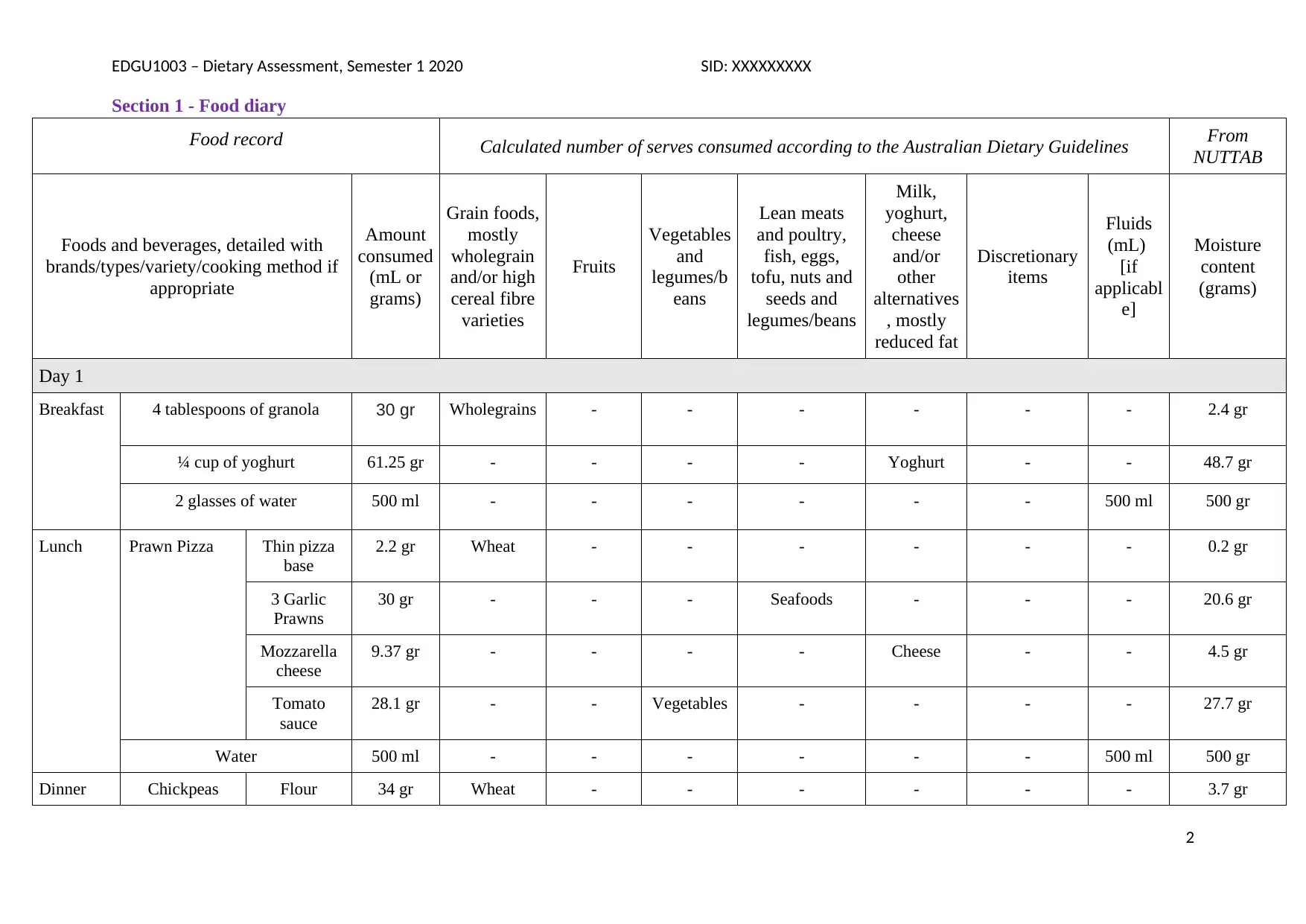
EDGU1003 – Dietary Assessment, Semester 1 2020 SID: XXXXXXXXX
Section 1 - Food diary
Food record Calculated number of serves consumed according to the Australian Dietary Guidelines From
NUTTAB
Foods and beverages, detailed with
brands/types/variety/cooking method if
appropriate
Amount
consumed
(mL or
grams)
Grain foods,
mostly
wholegrain
and/or high
cereal fibre
varieties
Fruits
Vegetables
and
legumes/b
eans
Lean meats
and poultry,
fish, eggs,
tofu, nuts and
seeds and
legumes/beans
Milk,
yoghurt,
cheese
and/or
other
alternatives
, mostly
reduced fat
Discretionary
items
Fluids
(mL)
[if
applicabl
e]
Moisture
content
(grams)
Day 1
Breakfast 4 tablespoons of granola 30 gr Wholegrains - - - - - - 2.4 gr
¼ cup of yoghurt 61.25 gr - - - - Yoghurt - - 48.7 gr
2 glasses of water 500 ml - - - - - - 500 ml 500 gr
Lunch Prawn Pizza Thin pizza
base
2.2 gr Wheat - - - - - - 0.2 gr
3 Garlic
Prawns
30 gr - - - Seafoods - - - 20.6 gr
Mozzarella
cheese
9.37 gr - - - - Cheese - - 4.5 gr
Tomato
sauce
28.1 gr - - Vegetables - - - - 27.7 gr
Water 500 ml - - - - - - 500 ml 500 gr
Dinner Chickpeas Flour 34 gr Wheat - - - - - - 3.7 gr
2
Section 1 - Food diary
Food record Calculated number of serves consumed according to the Australian Dietary Guidelines From
NUTTAB
Foods and beverages, detailed with
brands/types/variety/cooking method if
appropriate
Amount
consumed
(mL or
grams)
Grain foods,
mostly
wholegrain
and/or high
cereal fibre
varieties
Fruits
Vegetables
and
legumes/b
eans
Lean meats
and poultry,
fish, eggs,
tofu, nuts and
seeds and
legumes/beans
Milk,
yoghurt,
cheese
and/or
other
alternatives
, mostly
reduced fat
Discretionary
items
Fluids
(mL)
[if
applicabl
e]
Moisture
content
(grams)
Day 1
Breakfast 4 tablespoons of granola 30 gr Wholegrains - - - - - - 2.4 gr
¼ cup of yoghurt 61.25 gr - - - - Yoghurt - - 48.7 gr
2 glasses of water 500 ml - - - - - - 500 ml 500 gr
Lunch Prawn Pizza Thin pizza
base
2.2 gr Wheat - - - - - - 0.2 gr
3 Garlic
Prawns
30 gr - - - Seafoods - - - 20.6 gr
Mozzarella
cheese
9.37 gr - - - - Cheese - - 4.5 gr
Tomato
sauce
28.1 gr - - Vegetables - - - - 27.7 gr
Water 500 ml - - - - - - 500 ml 500 gr
Dinner Chickpeas Flour 34 gr Wheat - - - - - - 3.7 gr
2
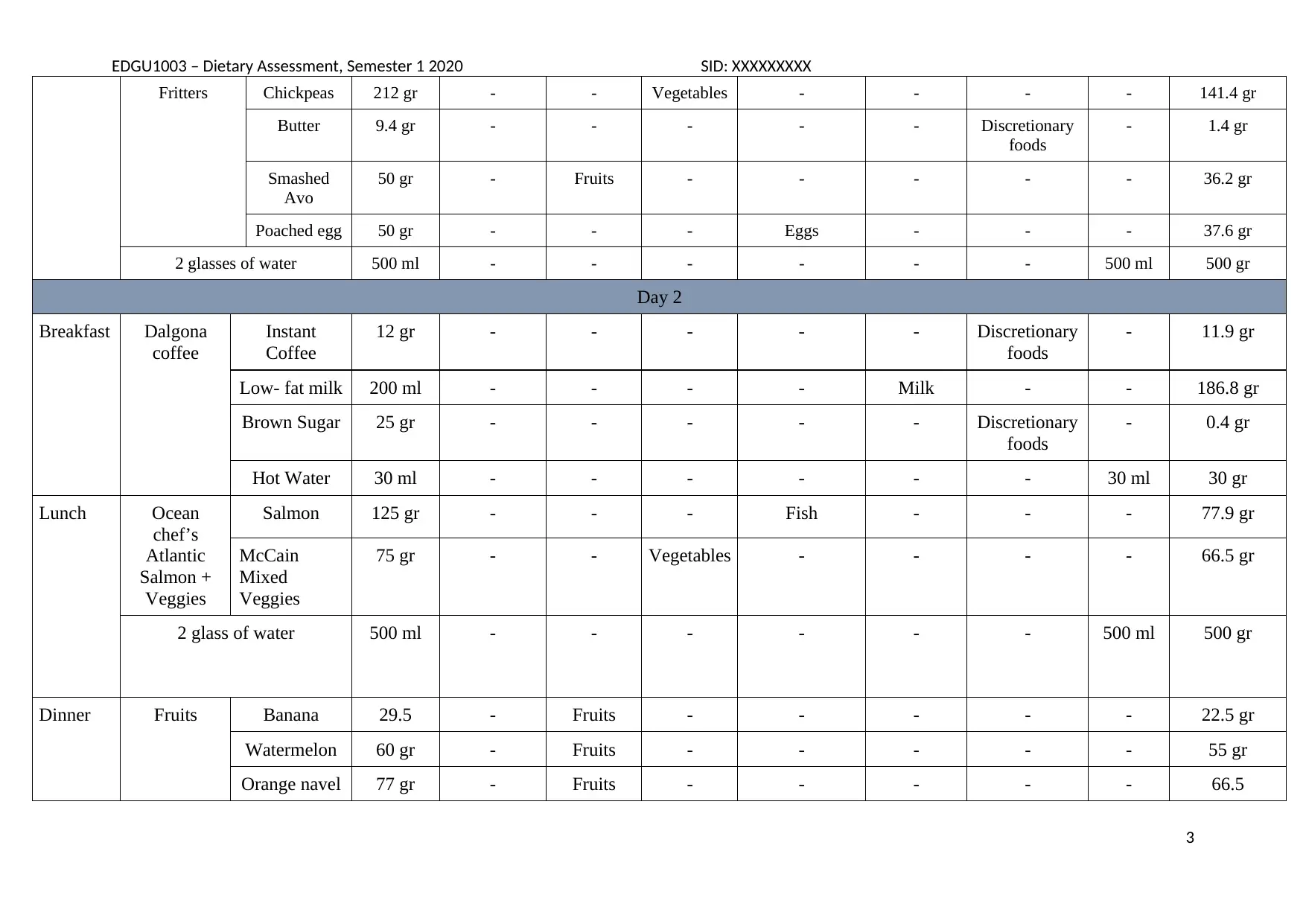
EDGU1003 – Dietary Assessment, Semester 1 2020 SID: XXXXXXXXX
Fritters Chickpeas 212 gr - - Vegetables - - - - 141.4 gr
Butter 9.4 gr - - - - - Discretionary
foods
- 1.4 gr
Smashed
Avo
50 gr - Fruits - - - - - 36.2 gr
Poached egg 50 gr - - - Eggs - - - 37.6 gr
2 glasses of water 500 ml - - - - - - 500 ml 500 gr
Day 2
Breakfast Dalgona
coffee
Instant
Coffee
12 gr - - - - - Discretionary
foods
- 11.9 gr
Low- fat milk 200 ml - - - - Milk - - 186.8 gr
Brown Sugar 25 gr - - - - - Discretionary
foods
- 0.4 gr
Hot Water 30 ml - - - - - - 30 ml 30 gr
Lunch Ocean
chef’s
Atlantic
Salmon +
Veggies
Salmon 125 gr - - - Fish - - - 77.9 gr
McCain
Mixed
Veggies
75 gr - - Vegetables - - - - 66.5 gr
2 glass of water 500 ml - - - - - - 500 ml 500 gr
Dinner Fruits Banana 29.5 - Fruits - - - - - 22.5 gr
Watermelon 60 gr - Fruits - - - - - 55 gr
Orange navel 77 gr - Fruits - - - - - 66.5
3
Fritters Chickpeas 212 gr - - Vegetables - - - - 141.4 gr
Butter 9.4 gr - - - - - Discretionary
foods
- 1.4 gr
Smashed
Avo
50 gr - Fruits - - - - - 36.2 gr
Poached egg 50 gr - - - Eggs - - - 37.6 gr
2 glasses of water 500 ml - - - - - - 500 ml 500 gr
Day 2
Breakfast Dalgona
coffee
Instant
Coffee
12 gr - - - - - Discretionary
foods
- 11.9 gr
Low- fat milk 200 ml - - - - Milk - - 186.8 gr
Brown Sugar 25 gr - - - - - Discretionary
foods
- 0.4 gr
Hot Water 30 ml - - - - - - 30 ml 30 gr
Lunch Ocean
chef’s
Atlantic
Salmon +
Veggies
Salmon 125 gr - - - Fish - - - 77.9 gr
McCain
Mixed
Veggies
75 gr - - Vegetables - - - - 66.5 gr
2 glass of water 500 ml - - - - - - 500 ml 500 gr
Dinner Fruits Banana 29.5 - Fruits - - - - - 22.5 gr
Watermelon 60 gr - Fruits - - - - - 55 gr
Orange navel 77 gr - Fruits - - - - - 66.5
3
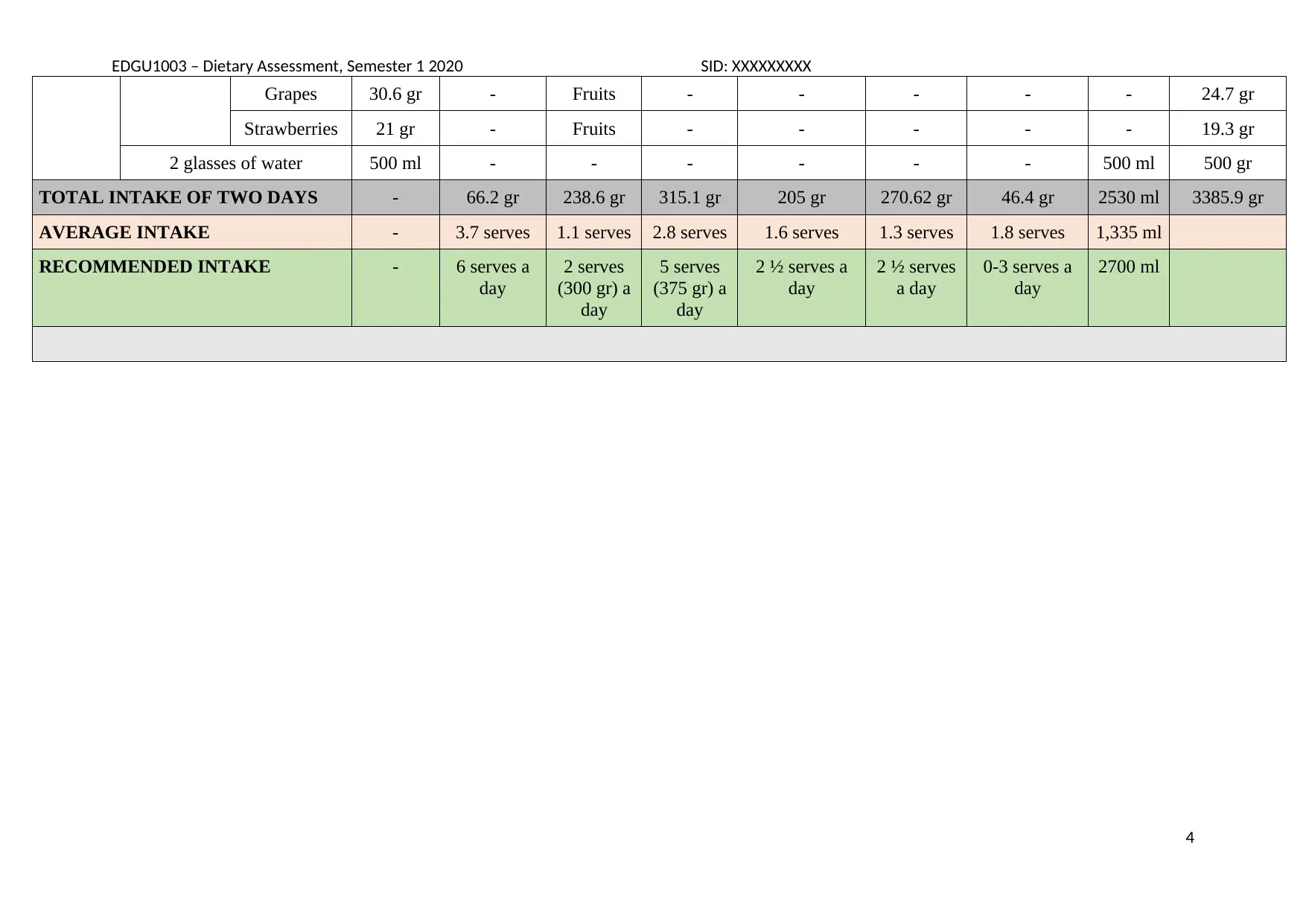
EDGU1003 – Dietary Assessment, Semester 1 2020 SID: XXXXXXXXX
Grapes 30.6 gr - Fruits - - - - - 24.7 gr
Strawberries 21 gr - Fruits - - - - - 19.3 gr
2 glasses of water 500 ml - - - - - - 500 ml 500 gr
TOTAL INTAKE OF TWO DAYS - 66.2 gr 238.6 gr 315.1 gr 205 gr 270.62 gr 46.4 gr 2530 ml 3385.9 gr
AVERAGE INTAKE - 3.7 serves 1.1 serves 2.8 serves 1.6 serves 1.3 serves 1.8 serves 1,335 ml
RECOMMENDED INTAKE - 6 serves a
day
2 serves
(300 gr) a
day
5 serves
(375 gr) a
day
2 ½ serves a
day
2 ½ serves
a day
0-3 serves a
day
2700 ml
4
Grapes 30.6 gr - Fruits - - - - - 24.7 gr
Strawberries 21 gr - Fruits - - - - - 19.3 gr
2 glasses of water 500 ml - - - - - - 500 ml 500 gr
TOTAL INTAKE OF TWO DAYS - 66.2 gr 238.6 gr 315.1 gr 205 gr 270.62 gr 46.4 gr 2530 ml 3385.9 gr
AVERAGE INTAKE - 3.7 serves 1.1 serves 2.8 serves 1.6 serves 1.3 serves 1.8 serves 1,335 ml
RECOMMENDED INTAKE - 6 serves a
day
2 serves
(300 gr) a
day
5 serves
(375 gr) a
day
2 ½ serves a
day
2 ½ serves
a day
0-3 serves a
day
2700 ml
4
Secure Best Marks with AI Grader
Need help grading? Try our AI Grader for instant feedback on your assignments.
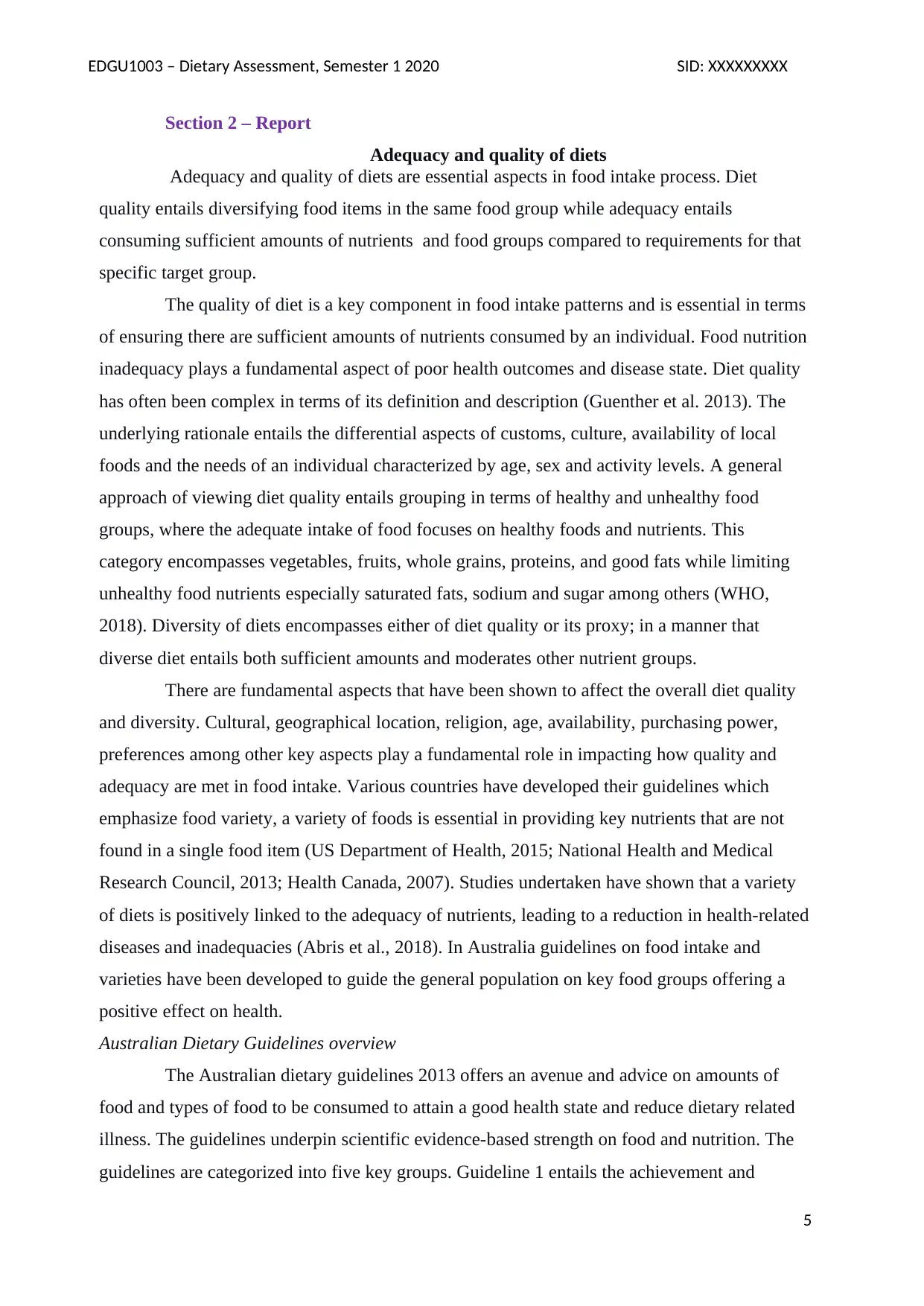
EDGU1003 – Dietary Assessment, Semester 1 2020 SID: XXXXXXXXX
Section 2 – Report
Adequacy and quality of diets
Adequacy and quality of diets are essential aspects in food intake process. Diet
quality entails diversifying food items in the same food group while adequacy entails
consuming sufficient amounts of nutrients and food groups compared to requirements for that
specific target group.
The quality of diet is a key component in food intake patterns and is essential in terms
of ensuring there are sufficient amounts of nutrients consumed by an individual. Food nutrition
inadequacy plays a fundamental aspect of poor health outcomes and disease state. Diet quality
has often been complex in terms of its definition and description (Guenther et al. 2013). The
underlying rationale entails the differential aspects of customs, culture, availability of local
foods and the needs of an individual characterized by age, sex and activity levels. A general
approach of viewing diet quality entails grouping in terms of healthy and unhealthy food
groups, where the adequate intake of food focuses on healthy foods and nutrients. This
category encompasses vegetables, fruits, whole grains, proteins, and good fats while limiting
unhealthy food nutrients especially saturated fats, sodium and sugar among others (WHO,
2018). Diversity of diets encompasses either of diet quality or its proxy; in a manner that
diverse diet entails both sufficient amounts and moderates other nutrient groups.
There are fundamental aspects that have been shown to affect the overall diet quality
and diversity. Cultural, geographical location, religion, age, availability, purchasing power,
preferences among other key aspects play a fundamental role in impacting how quality and
adequacy are met in food intake. Various countries have developed their guidelines which
emphasize food variety, a variety of foods is essential in providing key nutrients that are not
found in a single food item (US Department of Health, 2015; National Health and Medical
Research Council, 2013; Health Canada, 2007). Studies undertaken have shown that a variety
of diets is positively linked to the adequacy of nutrients, leading to a reduction in health-related
diseases and inadequacies (Abris et al., 2018). In Australia guidelines on food intake and
varieties have been developed to guide the general population on key food groups offering a
positive effect on health.
Australian Dietary Guidelines overview
The Australian dietary guidelines 2013 offers an avenue and advice on amounts of
food and types of food to be consumed to attain a good health state and reduce dietary related
illness. The guidelines underpin scientific evidence-based strength on food and nutrition. The
guidelines are categorized into five key groups. Guideline 1 entails the achievement and
5
Section 2 – Report
Adequacy and quality of diets
Adequacy and quality of diets are essential aspects in food intake process. Diet
quality entails diversifying food items in the same food group while adequacy entails
consuming sufficient amounts of nutrients and food groups compared to requirements for that
specific target group.
The quality of diet is a key component in food intake patterns and is essential in terms
of ensuring there are sufficient amounts of nutrients consumed by an individual. Food nutrition
inadequacy plays a fundamental aspect of poor health outcomes and disease state. Diet quality
has often been complex in terms of its definition and description (Guenther et al. 2013). The
underlying rationale entails the differential aspects of customs, culture, availability of local
foods and the needs of an individual characterized by age, sex and activity levels. A general
approach of viewing diet quality entails grouping in terms of healthy and unhealthy food
groups, where the adequate intake of food focuses on healthy foods and nutrients. This
category encompasses vegetables, fruits, whole grains, proteins, and good fats while limiting
unhealthy food nutrients especially saturated fats, sodium and sugar among others (WHO,
2018). Diversity of diets encompasses either of diet quality or its proxy; in a manner that
diverse diet entails both sufficient amounts and moderates other nutrient groups.
There are fundamental aspects that have been shown to affect the overall diet quality
and diversity. Cultural, geographical location, religion, age, availability, purchasing power,
preferences among other key aspects play a fundamental role in impacting how quality and
adequacy are met in food intake. Various countries have developed their guidelines which
emphasize food variety, a variety of foods is essential in providing key nutrients that are not
found in a single food item (US Department of Health, 2015; National Health and Medical
Research Council, 2013; Health Canada, 2007). Studies undertaken have shown that a variety
of diets is positively linked to the adequacy of nutrients, leading to a reduction in health-related
diseases and inadequacies (Abris et al., 2018). In Australia guidelines on food intake and
varieties have been developed to guide the general population on key food groups offering a
positive effect on health.
Australian Dietary Guidelines overview
The Australian dietary guidelines 2013 offers an avenue and advice on amounts of
food and types of food to be consumed to attain a good health state and reduce dietary related
illness. The guidelines underpin scientific evidence-based strength on food and nutrition. The
guidelines are categorized into five key groups. Guideline 1 entails the achievement and
5
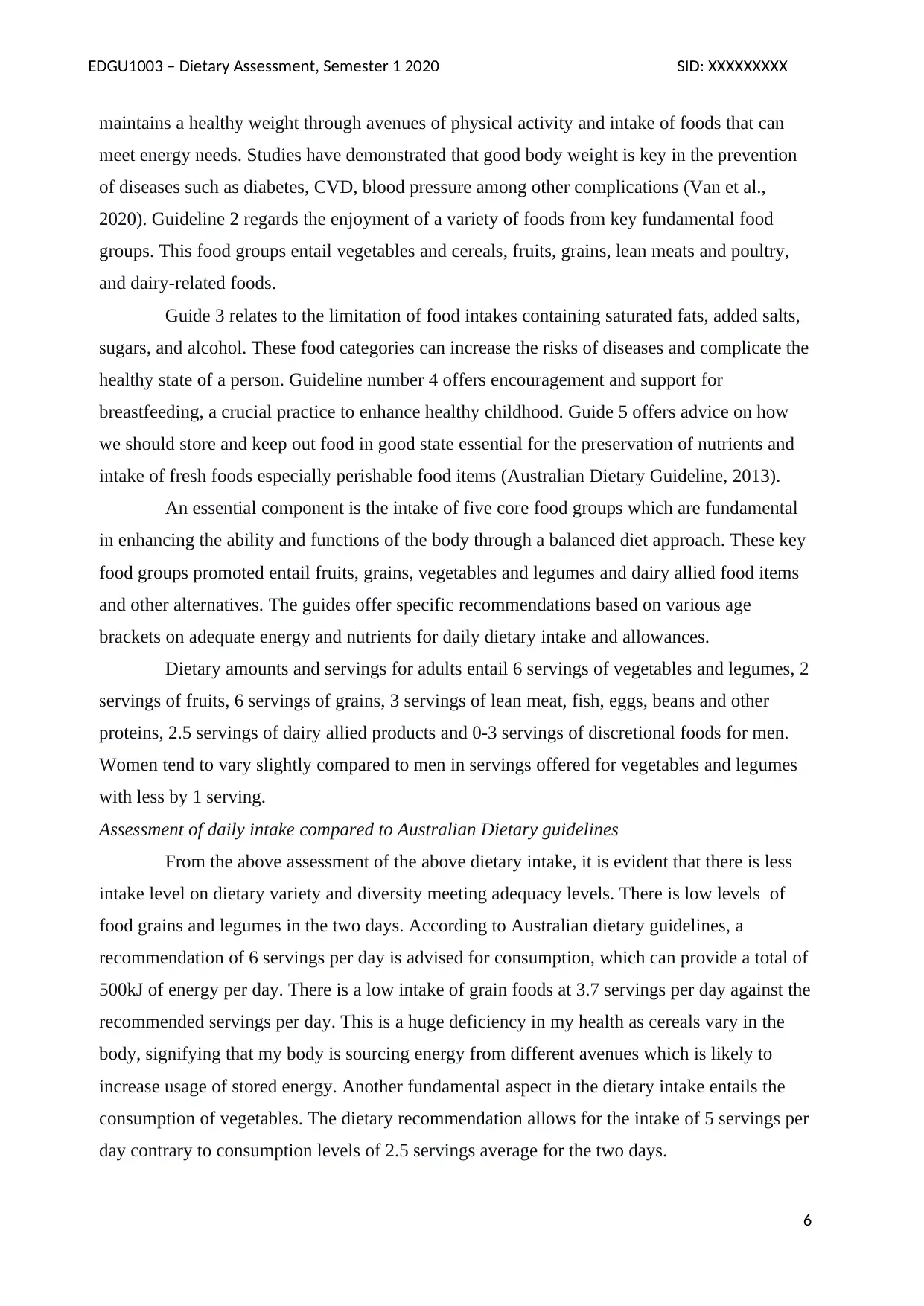
EDGU1003 – Dietary Assessment, Semester 1 2020 SID: XXXXXXXXX
maintains a healthy weight through avenues of physical activity and intake of foods that can
meet energy needs. Studies have demonstrated that good body weight is key in the prevention
of diseases such as diabetes, CVD, blood pressure among other complications (Van et al.,
2020). Guideline 2 regards the enjoyment of a variety of foods from key fundamental food
groups. This food groups entail vegetables and cereals, fruits, grains, lean meats and poultry,
and dairy-related foods.
Guide 3 relates to the limitation of food intakes containing saturated fats, added salts,
sugars, and alcohol. These food categories can increase the risks of diseases and complicate the
healthy state of a person. Guideline number 4 offers encouragement and support for
breastfeeding, a crucial practice to enhance healthy childhood. Guide 5 offers advice on how
we should store and keep out food in good state essential for the preservation of nutrients and
intake of fresh foods especially perishable food items (Australian Dietary Guideline, 2013).
An essential component is the intake of five core food groups which are fundamental
in enhancing the ability and functions of the body through a balanced diet approach. These key
food groups promoted entail fruits, grains, vegetables and legumes and dairy allied food items
and other alternatives. The guides offer specific recommendations based on various age
brackets on adequate energy and nutrients for daily dietary intake and allowances.
Dietary amounts and servings for adults entail 6 servings of vegetables and legumes, 2
servings of fruits, 6 servings of grains, 3 servings of lean meat, fish, eggs, beans and other
proteins, 2.5 servings of dairy allied products and 0-3 servings of discretional foods for men.
Women tend to vary slightly compared to men in servings offered for vegetables and legumes
with less by 1 serving.
Assessment of daily intake compared to Australian Dietary guidelines
From the above assessment of the above dietary intake, it is evident that there is less
intake level on dietary variety and diversity meeting adequacy levels. There is low levels of
food grains and legumes in the two days. According to Australian dietary guidelines, a
recommendation of 6 servings per day is advised for consumption, which can provide a total of
500kJ of energy per day. There is a low intake of grain foods at 3.7 servings per day against the
recommended servings per day. This is a huge deficiency in my health as cereals vary in the
body, signifying that my body is sourcing energy from different avenues which is likely to
increase usage of stored energy. Another fundamental aspect in the dietary intake entails the
consumption of vegetables. The dietary recommendation allows for the intake of 5 servings per
day contrary to consumption levels of 2.5 servings average for the two days.
6
maintains a healthy weight through avenues of physical activity and intake of foods that can
meet energy needs. Studies have demonstrated that good body weight is key in the prevention
of diseases such as diabetes, CVD, blood pressure among other complications (Van et al.,
2020). Guideline 2 regards the enjoyment of a variety of foods from key fundamental food
groups. This food groups entail vegetables and cereals, fruits, grains, lean meats and poultry,
and dairy-related foods.
Guide 3 relates to the limitation of food intakes containing saturated fats, added salts,
sugars, and alcohol. These food categories can increase the risks of diseases and complicate the
healthy state of a person. Guideline number 4 offers encouragement and support for
breastfeeding, a crucial practice to enhance healthy childhood. Guide 5 offers advice on how
we should store and keep out food in good state essential for the preservation of nutrients and
intake of fresh foods especially perishable food items (Australian Dietary Guideline, 2013).
An essential component is the intake of five core food groups which are fundamental
in enhancing the ability and functions of the body through a balanced diet approach. These key
food groups promoted entail fruits, grains, vegetables and legumes and dairy allied food items
and other alternatives. The guides offer specific recommendations based on various age
brackets on adequate energy and nutrients for daily dietary intake and allowances.
Dietary amounts and servings for adults entail 6 servings of vegetables and legumes, 2
servings of fruits, 6 servings of grains, 3 servings of lean meat, fish, eggs, beans and other
proteins, 2.5 servings of dairy allied products and 0-3 servings of discretional foods for men.
Women tend to vary slightly compared to men in servings offered for vegetables and legumes
with less by 1 serving.
Assessment of daily intake compared to Australian Dietary guidelines
From the above assessment of the above dietary intake, it is evident that there is less
intake level on dietary variety and diversity meeting adequacy levels. There is low levels of
food grains and legumes in the two days. According to Australian dietary guidelines, a
recommendation of 6 servings per day is advised for consumption, which can provide a total of
500kJ of energy per day. There is a low intake of grain foods at 3.7 servings per day against the
recommended servings per day. This is a huge deficiency in my health as cereals vary in the
body, signifying that my body is sourcing energy from different avenues which is likely to
increase usage of stored energy. Another fundamental aspect in the dietary intake entails the
consumption of vegetables. The dietary recommendation allows for the intake of 5 servings per
day contrary to consumption levels of 2.5 servings average for the two days.
6
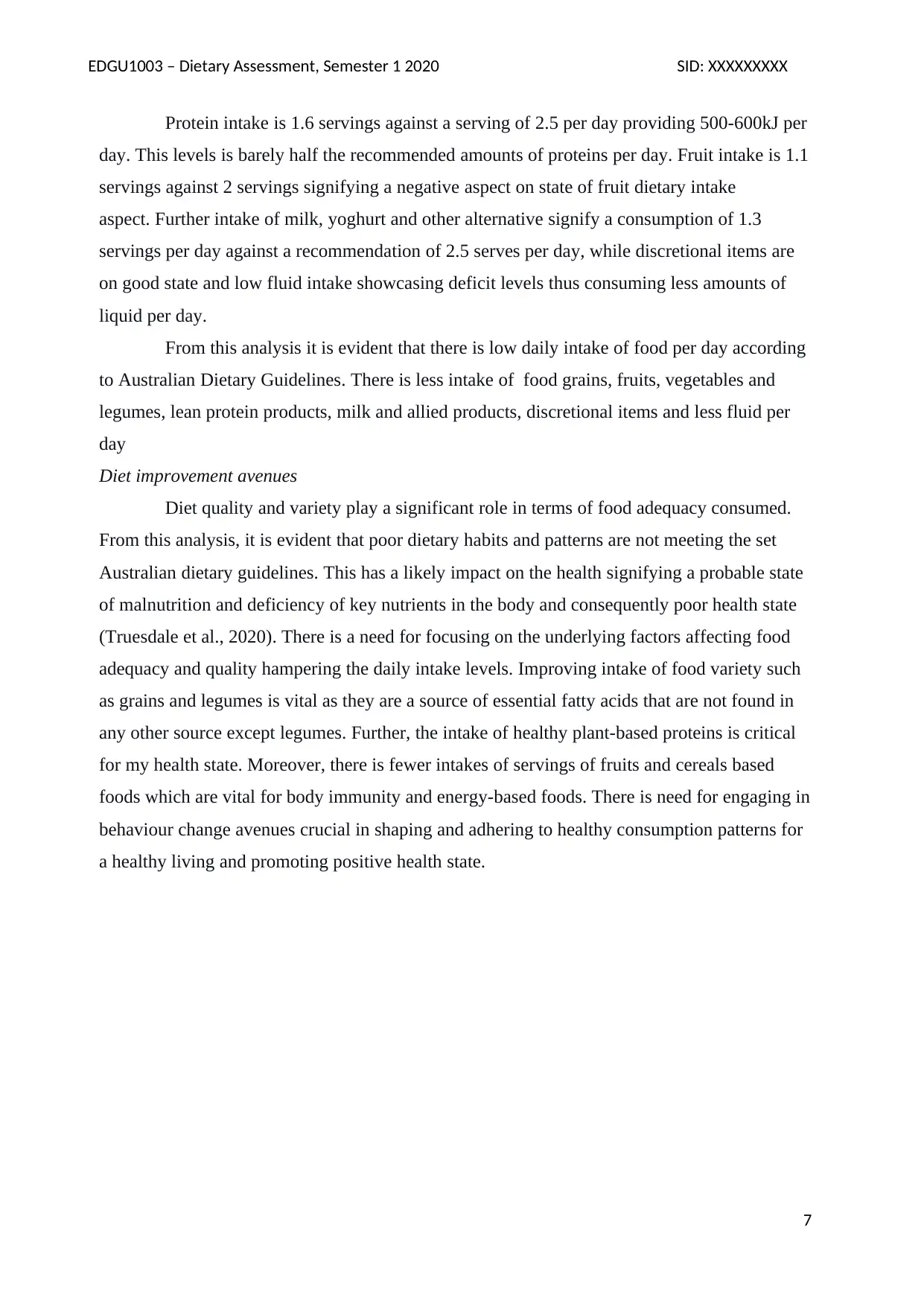
EDGU1003 – Dietary Assessment, Semester 1 2020 SID: XXXXXXXXX
Protein intake is 1.6 servings against a serving of 2.5 per day providing 500-600kJ per
day. This levels is barely half the recommended amounts of proteins per day. Fruit intake is 1.1
servings against 2 servings signifying a negative aspect on state of fruit dietary intake
aspect. Further intake of milk, yoghurt and other alternative signify a consumption of 1.3
servings per day against a recommendation of 2.5 serves per day, while discretional items are
on good state and low fluid intake showcasing deficit levels thus consuming less amounts of
liquid per day.
From this analysis it is evident that there is low daily intake of food per day according
to Australian Dietary Guidelines. There is less intake of food grains, fruits, vegetables and
legumes, lean protein products, milk and allied products, discretional items and less fluid per
day
Diet improvement avenues
Diet quality and variety play a significant role in terms of food adequacy consumed.
From this analysis, it is evident that poor dietary habits and patterns are not meeting the set
Australian dietary guidelines. This has a likely impact on the health signifying a probable state
of malnutrition and deficiency of key nutrients in the body and consequently poor health state
(Truesdale et al., 2020). There is a need for focusing on the underlying factors affecting food
adequacy and quality hampering the daily intake levels. Improving intake of food variety such
as grains and legumes is vital as they are a source of essential fatty acids that are not found in
any other source except legumes. Further, the intake of healthy plant-based proteins is critical
for my health state. Moreover, there is fewer intakes of servings of fruits and cereals based
foods which are vital for body immunity and energy-based foods. There is need for engaging in
behaviour change avenues crucial in shaping and adhering to healthy consumption patterns for
a healthy living and promoting positive health state.
7
Protein intake is 1.6 servings against a serving of 2.5 per day providing 500-600kJ per
day. This levels is barely half the recommended amounts of proteins per day. Fruit intake is 1.1
servings against 2 servings signifying a negative aspect on state of fruit dietary intake
aspect. Further intake of milk, yoghurt and other alternative signify a consumption of 1.3
servings per day against a recommendation of 2.5 serves per day, while discretional items are
on good state and low fluid intake showcasing deficit levels thus consuming less amounts of
liquid per day.
From this analysis it is evident that there is low daily intake of food per day according
to Australian Dietary Guidelines. There is less intake of food grains, fruits, vegetables and
legumes, lean protein products, milk and allied products, discretional items and less fluid per
day
Diet improvement avenues
Diet quality and variety play a significant role in terms of food adequacy consumed.
From this analysis, it is evident that poor dietary habits and patterns are not meeting the set
Australian dietary guidelines. This has a likely impact on the health signifying a probable state
of malnutrition and deficiency of key nutrients in the body and consequently poor health state
(Truesdale et al., 2020). There is a need for focusing on the underlying factors affecting food
adequacy and quality hampering the daily intake levels. Improving intake of food variety such
as grains and legumes is vital as they are a source of essential fatty acids that are not found in
any other source except legumes. Further, the intake of healthy plant-based proteins is critical
for my health state. Moreover, there is fewer intakes of servings of fruits and cereals based
foods which are vital for body immunity and energy-based foods. There is need for engaging in
behaviour change avenues crucial in shaping and adhering to healthy consumption patterns for
a healthy living and promoting positive health state.
7
Paraphrase This Document
Need a fresh take? Get an instant paraphrase of this document with our AI Paraphraser

EDGU1003 – Dietary Assessment, Semester 1 2020 SID: XXXXXXXXX
Appendix A
Photo Day and meal
Day 1 Breakfast
- Granola and Vanilla Yoghurt
Day 1 Lunch
- Garlic Prawn Pizza with Tomato base and
Mozzarella cheese
Day 1 Dinner
- Chickpeas Fritters + smashed Avocado and
poached egg
8
Appendix A
Photo Day and meal
Day 1 Breakfast
- Granola and Vanilla Yoghurt
Day 1 Lunch
- Garlic Prawn Pizza with Tomato base and
Mozzarella cheese
Day 1 Dinner
- Chickpeas Fritters + smashed Avocado and
poached egg
8

EDGU1003 – Dietary Assessment, Semester 1 2020 SID: XXXXXXXXX
Day 2 Breakfast
-Dalgona Coffee (Nescafe Gold instant coffee + brown sugar +
low fat milk)
Day 2 Lunch
- Ocean Chef Atlantic Salmon portion mediterranean
style herb with Mccain Mixed Vegetables peas,
corn and carrot
Day 2 Dinner
- Fruits (Red seedless grapes, banana, watermelon,
Strawberries, Orange Navel)
9
Day 2 Breakfast
-Dalgona Coffee (Nescafe Gold instant coffee + brown sugar +
low fat milk)
Day 2 Lunch
- Ocean Chef Atlantic Salmon portion mediterranean
style herb with Mccain Mixed Vegetables peas,
corn and carrot
Day 2 Dinner
- Fruits (Red seedless grapes, banana, watermelon,
Strawberries, Orange Navel)
9
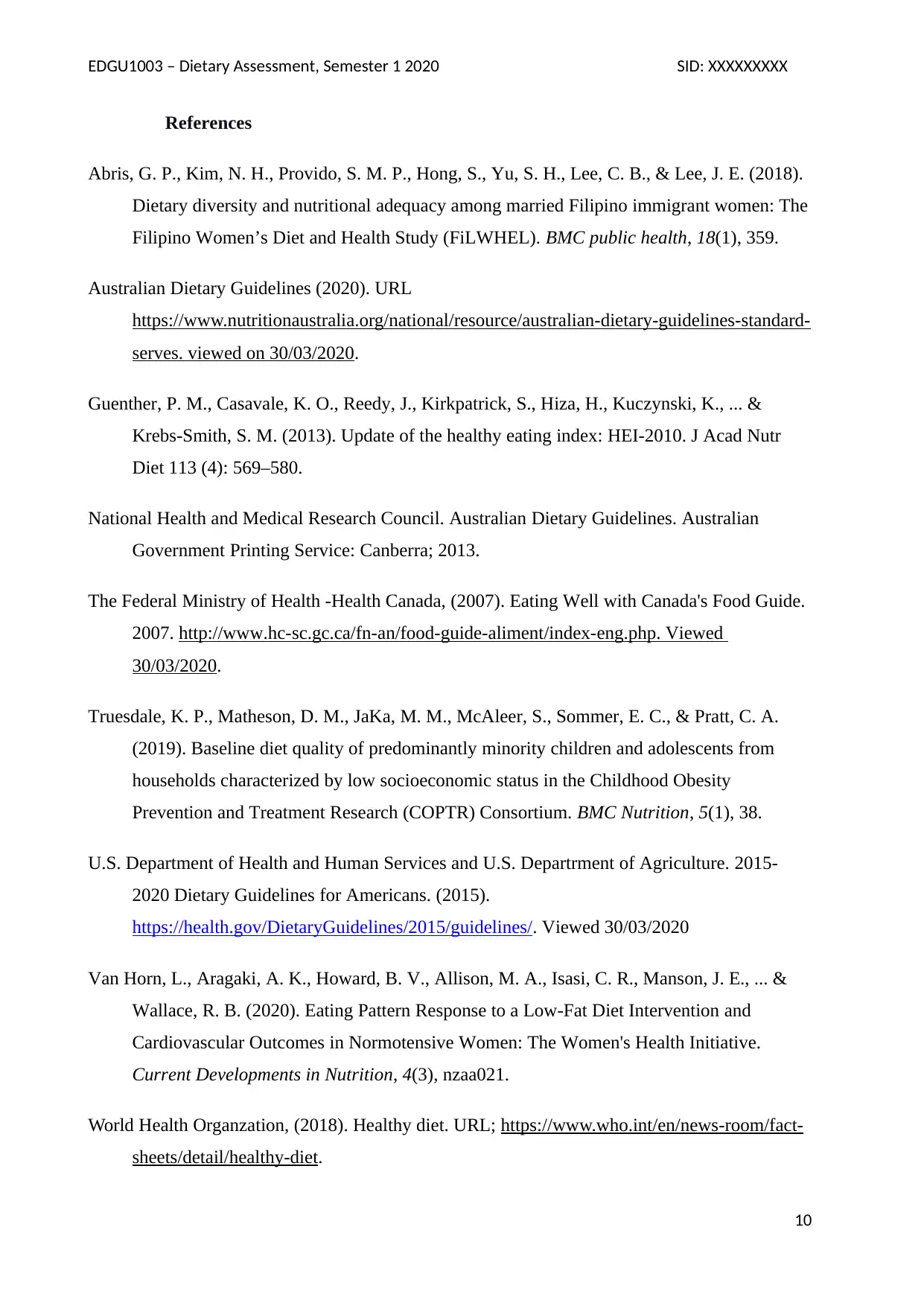
EDGU1003 – Dietary Assessment, Semester 1 2020 SID: XXXXXXXXX
References
Abris, G. P., Kim, N. H., Provido, S. M. P., Hong, S., Yu, S. H., Lee, C. B., & Lee, J. E. (2018).
Dietary diversity and nutritional adequacy among married Filipino immigrant women: The
Filipino Women’s Diet and Health Study (FiLWHEL). BMC public health, 18(1), 359.
Australian Dietary Guidelines (2020). URL
https://www.nutritionaustralia.org/national/resource/australian-dietary-guidelines-standard-
serves. viewed on 30/03/2020.
Guenther, P. M., Casavale, K. O., Reedy, J., Kirkpatrick, S., Hiza, H., Kuczynski, K., ... &
Krebs-Smith, S. M. (2013). Update of the healthy eating index: HEI-2010. J Acad Nutr
Diet 113 (4): 569–580.
National Health and Medical Research Council. Australian Dietary Guidelines. Australian
Government Printing Service: Canberra; 2013.
The Federal Ministry of Health -Health Canada, (2007). Eating Well with Canada's Food Guide.
2007. http://www.hc-sc.gc.ca/fn-an/food-guide-aliment/index-eng.php. Viewed
30/03/2020.
Truesdale, K. P., Matheson, D. M., JaKa, M. M., McAleer, S., Sommer, E. C., & Pratt, C. A.
(2019). Baseline diet quality of predominantly minority children and adolescents from
households characterized by low socioeconomic status in the Childhood Obesity
Prevention and Treatment Research (COPTR) Consortium. BMC Nutrition, 5(1), 38.
U.S. Department of Health and Human Services and U.S. Departrment of Agriculture. 2015-
2020 Dietary Guidelines for Americans. (2015).
https://health.gov/DietaryGuidelines/2015/guidelines/. Viewed 30/03/2020
Van Horn, L., Aragaki, A. K., Howard, B. V., Allison, M. A., Isasi, C. R., Manson, J. E., ... &
Wallace, R. B. (2020). Eating Pattern Response to a Low-Fat Diet Intervention and
Cardiovascular Outcomes in Normotensive Women: The Women's Health Initiative.
Current Developments in Nutrition, 4(3), nzaa021.
World Health Organzation, (2018). Healthy diet. URL; https://www.who.int/en/news-room/fact-
sheets/detail/healthy-diet.
10
References
Abris, G. P., Kim, N. H., Provido, S. M. P., Hong, S., Yu, S. H., Lee, C. B., & Lee, J. E. (2018).
Dietary diversity and nutritional adequacy among married Filipino immigrant women: The
Filipino Women’s Diet and Health Study (FiLWHEL). BMC public health, 18(1), 359.
Australian Dietary Guidelines (2020). URL
https://www.nutritionaustralia.org/national/resource/australian-dietary-guidelines-standard-
serves. viewed on 30/03/2020.
Guenther, P. M., Casavale, K. O., Reedy, J., Kirkpatrick, S., Hiza, H., Kuczynski, K., ... &
Krebs-Smith, S. M. (2013). Update of the healthy eating index: HEI-2010. J Acad Nutr
Diet 113 (4): 569–580.
National Health and Medical Research Council. Australian Dietary Guidelines. Australian
Government Printing Service: Canberra; 2013.
The Federal Ministry of Health -Health Canada, (2007). Eating Well with Canada's Food Guide.
2007. http://www.hc-sc.gc.ca/fn-an/food-guide-aliment/index-eng.php. Viewed
30/03/2020.
Truesdale, K. P., Matheson, D. M., JaKa, M. M., McAleer, S., Sommer, E. C., & Pratt, C. A.
(2019). Baseline diet quality of predominantly minority children and adolescents from
households characterized by low socioeconomic status in the Childhood Obesity
Prevention and Treatment Research (COPTR) Consortium. BMC Nutrition, 5(1), 38.
U.S. Department of Health and Human Services and U.S. Departrment of Agriculture. 2015-
2020 Dietary Guidelines for Americans. (2015).
https://health.gov/DietaryGuidelines/2015/guidelines/. Viewed 30/03/2020
Van Horn, L., Aragaki, A. K., Howard, B. V., Allison, M. A., Isasi, C. R., Manson, J. E., ... &
Wallace, R. B. (2020). Eating Pattern Response to a Low-Fat Diet Intervention and
Cardiovascular Outcomes in Normotensive Women: The Women's Health Initiative.
Current Developments in Nutrition, 4(3), nzaa021.
World Health Organzation, (2018). Healthy diet. URL; https://www.who.int/en/news-room/fact-
sheets/detail/healthy-diet.
10
1 out of 10
Related Documents
Your All-in-One AI-Powered Toolkit for Academic Success.
+13062052269
info@desklib.com
Available 24*7 on WhatsApp / Email
![[object Object]](/_next/static/media/star-bottom.7253800d.svg)
Unlock your academic potential
© 2024 | Zucol Services PVT LTD | All rights reserved.





